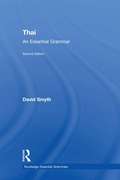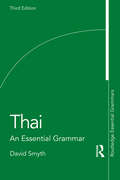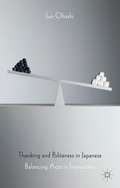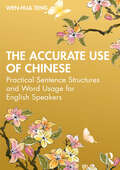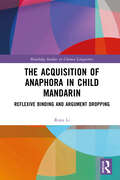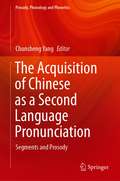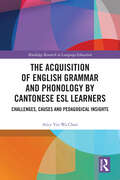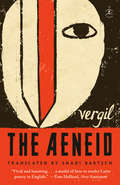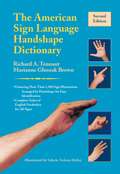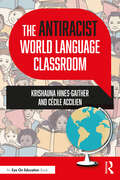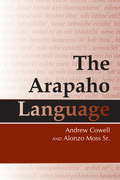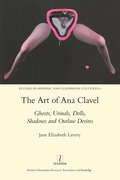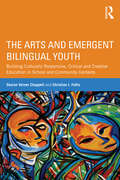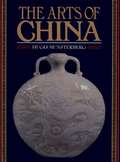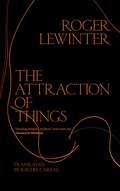- Table View
- List View
Thai: An Essential Grammar (Routledge Essential Grammars)
by David SmythThis second edition of Thai: An Essential Grammar provides an up-to-date and concise reference guide to Thai grammar. Using clear, jargon-free explanations, it sets out the complexities of Thai in short, readable sections and presents an accessible description of the language. Focus is kept on the real patterns of use today and grammar forms are demonstrated through a wide range of relevant examples. No prior knowledge is assumed on the part of the reader. Features include: Coverage of crucial topics, such as sentence particles, negation, questions and quantification Examples given in both Thai script and romanised transliteration Pronunciation section Guidance on speech conventions and the Thai writing system Glossary of grammatical terms Two appendices covering Romanisation systems and three key verbs Bibliography This unique reference work will prove invaluable to all learners looking to master the grammar of Thai. It is ideal either for independent study or for students in schools, colleges, universities and adult classes of all types.
Thai: An Essential Grammar (Routledge Essential Grammars)
by David SmythThis third edition of Thai: An Essential Grammar provides an up-to-date and concise reference guide to Thai grammar.Using clear, jargon-free explanations, it sets out the complexities of Thai in short, readable sections and presents an accessible description of the language. Focus is kept on the real patterns of use today and grammar forms are demonstrated through a wide range of relevant examples. No prior knowledge is assumed on the part of the reader.Features include: coverage of crucial topics, such as sentence particles, negation, questions and quantification examples given in both Thai script and romanised transliteration pronunciation section guidance on speech conventions and the Thai writing system glossary of grammatical terms two appendices covering romanisation systems and three key verbs bibliography This unique reference work will prove invaluable to all learners looking to master the grammar of Thai. It is ideal for both independent study and for students in schools, colleges, universities and adult classes of all types.
Thamiz Inru
by A. RavisankarThis book is a collection of articles written by the Author in his Blog from 2005 to 2013 about the state of Tamil language and how to write and read Tamil in computers and smart phones.
Thandiyalangaram
by V. T. RamasubramaniyamThandiyalangaram is the most referred text for 'Ani Ilakkiyam' which is part of the five broad categories of Tamil grammar named 'Ainthilakkiyam'.
Thandiyalangaram
by V. T. RamasubramaniyamThandiyalangaram is the most referred text for 'Ani Ilakkiyam' which is part of the five broad categories of Tamil grammar named 'Ainthilakkiyam'.
Thandiyalangaram
by V. T. RamasubramaniyamThandiyalangaram is the most referred text for 'Ani Ilakkiyam' which is part of the five broad categories of Tamil grammar named 'Ainthilakkiyam'.
Thandiyalangaram
by V. T. RamasubramaniyamThandiyalangaram is the most referred text for 'Ani Ilakkiyam' which is part of the five broad categories of Tamil grammar named 'Ainthilakkiyam'.
Thanking and Politeness in Japanese
by Jun OhashiThis book synthesizes previous work on thanking, politeness and Japanese pragmatics and crystallises the theoretical underpinnings of thanking, how it is realized linguistically and the social meaning and significance of this aspect of Japanese communication.
The Accurate Use of Chinese: Practical Sentence Structures and Word Usage for English Speakers
by Wen-Hua TengThe Accurate Use of Chinese: Practical Sentence Structures and Word Usage for English Speakers is a unique learning resource for learners of Chinese who are English speakers. The primary goal is two-fold: to help these learners leverage their existent knowledge in English and navigate the Chinese system with fewer obstacles; and also to help them prevent errors of which the underlying cause may be English. This is done through comparisons of selected grammar topics, language rules and word usages between the two languages. Grammar topics in English serve as the comparison points from which learners can gain a deeper understanding of the comparable, but differing structures in Chinese. The book's comparative approach is unique and innovative, designed to build a more nuanced and instinctive approach to grammar. A valuable resource for beginners to advanced learners and instructors of Chinese, the book contextualizes grammar structures and provides in-depth information not covered in Chinese language textbooks.
The Acquisition of Anaphora in Child Mandarin: Reflexive Binding and Argument Dropping (Routledge Studies in Chinese Linguistics)
by Ruya LiThe Acquisition of Anaphora in Child Mandarin explores how Mandarin-speaking children’s interpretation of the reflexive ziji and their use of null arguments can be understood under the notions of locality and prominence.This book investigates the interpretation of ziji and the use of null subjects and null objects by experimenting on Mandarin-speaking children and adults using a range of experimental techniques such as the truth value judgment task, the picture identification task, and the story-telling task.The book provides evidence to show that reflexive binding and argument dropping are determined by the interplay between universal principles and language-specific properties. It shows that children at the age of 4 make an adult-like distinction between the anaphoric and logophoric interpretations of ziji. The former is subject to the locality condition manifested by the blocking effect on the long-distance binding of ziji, whereas the latter is free from the locality condition and closely related to the understanding of the false beliefs of others.This book is an important contribution to language acquisition research and can serve as a valuable reference for graduate students and researchers in the field of language acquisition, Chinese linguistics, psycholinguistics, and cognitive science.
The Acquisition of Chinese as a Second Language Pronunciation: Segments and Prosody (Prosody, Phonology and Phonetics)
by Chunsheng YangThis book is the first edited book to cover a wide range of issues related to Chinese as a second language (CSL) speech, including tone and segment acquisition and processing, categorical perception of tones, CSL fluency, CSL intelligibility/comprehensibility and accentedness, and pronunciation pedagogy. Moreover, the book addresses both theoretical and pedagogical issues. It offers an essential go-to book for anyone who is interested in CSL speech, e.g. CSL speech researchers, Chinese instructors, CSL learners, and anyone interested in second language speech.
The Acquisition of Creole Languages
by Dany AdoneHow do children acquire a Creole as their first language? This relatively underexplored question is the starting point for this first book of its kind; it also asks how first language acquisition of a Creole differs from that of a non-Creole language. Dany Adone reveals that in the absence of a conventional language model, Creole children acquire language and go beyond the input they receive. This study discusses the role of input, a hotly debated issue in the field of first language acquisition, and provides support for the nativist approach in the debate between nativism and input-based models. The Acquisition of Creole Languages will be essential reading for those in the fields of first language acquisition and Creole studies. Adone takes an interdisciplinary approach, using insights from non-verbal language acquisition, which makes this of great interest to those in the field of sign linguistics.
The Acquisition of English Grammar and Phonology by Cantonese ESL Learners: Challenges, Causes and Pedagogical Insights (Routledge Research in Language Education)
by Alice Yin ChanChan’s exploration of the acquisition of English grammar and phonology by Cantonese learners of English as a Second Language (ESL) offers insights into the specific challenges that learners often encounter and posits ways to help them overcome those challenges. Possible sources of the challenges are also examined. The book covers the basic differences between English and Cantonese grammar as well as those between English and Cantonese phonology. Chan discusses the kinds of grammatical and phonological problems that Cantonese ESL learners often have in their acquisition of English. In terms of grammar, various structures are reviewed, including errors which are clearly due to L1 interference and also those which may not be directly L1-related. Learners’ common misconceptions about relevant concepts are also revealed. In terms of phonology, both speech perception and speech production problems at the segmental and suprasegmental levels are examined. For learner problems which may be the result of L1 interference, a contrastive approach is adopted in analysing the cause and nature of the errors. Chan also offers readers pedagogical insights to target common grammatical problems, including the use of an algorithmic approach, the use of a discovery-based consciousness-raising approach and the use of metalinguistic explanations. As far as the learning of English phonology is concerned, she argues that the training of speech production should go hand-in-hand with that of speech perception. Future research can experiment with the proposed teaching ideas with Cantonese ESL learners and learners of other native languages. Researchers and ESL teaching professionals will find the insights and research contained within this volume invaluable when encountering or researching Chinese ESL learners.
The Aeneid: Translated By Shadi Bartsch (Barnes And Noble Classics Ser.)
by Virgil VergilA fresh and faithful translation of Vergil&’s Aeneid restores the epic&’s spare language and fast pace and sheds new light on one of the cornerstone narratives of Western culture.&“The best version of the Aeneid in modern English: concise, readable and beautiful, but also as accurate and faithful to Vergil&’s Latin as possible.&”—James J. O&’Hara, George L. Paddison Professor of Latin, University of North Carolina at Chapel HillFor two thousand years, the epic tale of Aeneas&’s dramatic flight from Troy, his doomed love affair with Dido, his descent into the underworld, and the bloody story behind the establishment of Rome has electrified audiences around the world. In Vergil&’s telling, Aeneas&’s heroic journey not only gave Romans and Italians a thrilling origin story, it established many of the fundamental themes of Western life and literature—the role of duty and self-sacrifice, the place of love and passion in human life, the relationship between art and violence, the tension between immigrant and indigenous people, and the way new foundations are so often built upon the wreckage of those who came before. Throughout the course of Western history, the Aeneid has affirmed our best and worst intentions and forced us to confront our deepest contradictions.Shadi Bartsch, Guggenheim Laureate, award-winning translator, and chaired professor at the University of Chicago, confronts the contradictions inherent in the text itself, illuminating the epic&’s subversive approach to storytelling. Even as Vergil writes the foundation myth for Rome, he seems to comment on this tendency to mythologize our heroes and societies, and to gesture to the stories that get lost in the mythmaking. Bartsch&’s groundbreaking translation, brilliantly maintaining the brisk pace of Vergil&’s Latin even as it offers readers a metrical line-by-line translation, provides a literary and historical context to make the Aeneid resonant for a new generation of readers.
The Aesthetics of Grammar
by Jeffrey P. WilliamsThe languages of mainland Southeast Asia evidence an impressive array of elaborate grammatical resources, such as echo words, phonaesthetic words, chameleon affixes, chiming derivatives, onomatopoeic forms, ideophones and expressives. Speakers of these languages fashion grammatical works of art in order to express and convey emotions, senses, conditions and perceptions that enrich discourse. This book provides a detailed comparative overview of the mechanisms by which aesthetic qualities of speech operate as part of speakers' grammatical knowledge. Each chapter focuses on a different language and explores the grammatical information of a number of well- and lesser-known languages from mainland Southeast Asia. It will be of great interest to syntacticians, morphologists, linguistic anthropologists, language typologists, cognitive scientists interested in language, and instructors of Southeast Asian languages.
The Afroasiatic Languages
by Zygmunt Frajzyngier Erin ShayAfroasiatic languages are spoken by some 300 million people in Northern, Central and Eastern Africa and the Middle East. This book is the first typological study of these languages, which are comprised of around 375 living and extinct varieties. They are an important object of study because of their typological diversity in the areas of phonology (some have tone; others do not), morphology (some have extensive inflectional systems; others do not), position of the verb in the clause (some are verb-initial, some are verb-medial, and some are verb-final) and in the semantic functions they encode. This book documents this typological diversity and the typological similarities across the languages and includes information on endangered and little-known languages. Requiring no previous knowledge of the specific language families, it will be welcomed by linguists interested in linguistic theory, typology, historical linguistics and endangered languages, as well as scholars of Africa and the Middle East.
The American Sign Language Handshape Dictionary
by Richard A. Tennant Marianne Gluszak BrownThis unique reference can help users locate a sign whose meaning they have forgotten, or help them find the meaning of a new sign they have just seen for the first time. It organizes more than 1,900 ASL signs by 40 basic handshapes and includes detailed descriptions on how to form these signs to represent the different English words that they might mean. Users can begin to track down a sign by determining whether it is formed with one hand or two. Further distinctions of handshape, palm orientation, location, movement, and nonmanual signals help them pinpoint their search while also refining their grasp of ASL syntax and grammar. A complete English word index provides the option of referring to an alphabetical listing of English terms to locate an equivalent sign or choice of signs. This dictionary features: More than 1,900 sign illustrations, organized by handshape Complete index of English vocabulary for all signs An introduction to Deaf culture and ASL structure The American Sign Language Handshape Dictionary is a one-of-a-kind resource for learning ASL and enhancing communication skills in both ASL and English.
The Ancient Egyptian Language
by James P. AllenThis book, the first of its kind, examines how the phonology and grammar of the ancient Egyptian language changed over more than three thousand years of its history, from the first appearance of written documents, c. 3250 BC, to the Coptic dialects of the second century AD and later. Part One discusses phonology, working backward from the vowels and consonants of Coptic to those that can be deduced for earlier stages of the language. Part Two is devoted to grammar, including both basic components such as nouns and the complex history of the verbal system. The book thus provides both a synchronic description of the five major historical stages of ancient Egyptian and a diachronic analysis of their development and relationship.
The Antiracist World Language Classroom
by Cécile Accilien Krishauna Hines-GaitherHow can you incorporate antiracist practices into specific subject areas? This essential book finally answers that question and offers a clear roadmap for introducing antiracism into the world language classroom. Drawing on foundational and cutting-edge knowledge of antiracism, authors Hines-Gaither and Accilien address the following questions: what does antiracism look like in the world language classroom; why is it vital to implement antiracist practices relevant to your classroom or school; and how can you enact antiracist pedagogies and practices that enrich and benefit your classroom or school? Aligned with the American Council on the Teaching of Foreign Languages standards, the book is filled with hands-on antiracist activities, strategies, and lesson plans. The book covers all necessary topics, including designing antiracist units of study, teaching across proficiency levels, advocacy and collaboration in the community, and how to facilitate self- reflection to become an active antiracist educator. The tools, prompts, and resources in this book are essential for any world language teacher, department chair, or school leader.
The Arapaho Language: Language And Power Among The Northern Arapaho
by Andrew Cowell Alonzo Moss, Sr.The Arapaho Language is the definitive reference grammar of an endangered Algonquian language. Arapaho differs strikingly from other Algonquian languages, making it particularly relevant to the study of historical linguistics and the evolution of grammar. Andrew Cowell and Alonzo Moss Sr. document Arapaho's interesting features, including a pitch-based accent system with no exact Algonquian parallels, radical innovations in the verb system, and complex contrasts between affirmative and non-affirmative statements. Cowell and Moss detail strategies used by speakers of this highly polysynthetic language to form complex words and illustrate how word formation interacts with information structure. They discuss word order and discourse-level features, treat the special features of formal discourse style and traditional narratives, and list gender-specific particles, which are widely used in conversation. Appendices include full sets of inflections for a variety of verbs. Arapaho is spoken primarily in Wyoming, with a few speakers in Oklahoma. The corpus used in The Arapaho Language spans more than a century of documentation, including multiple speakers from Wyoming and Oklahoma, with emphasis on recent recordings from Wyoming. The book cites approximately 2,000 language examples drawn largely from natural discourse - either recorded spoken language or texts written by native speakers. With The Arapaho Language, Cowell and Moss have produced a comprehensive document of a language that, in its departures from its nearest linguistic neighbors, sheds light on the evolution of grammar.
The Art of Ana Clavel: Ghosts, Urinals, Dolls, Shadows and Outlaw Desires
by JaneElizabeth LaveryAna Clavel is a remarkable contemporary Mexican writer whose literary and multimedia oeuvre is marked by its queerness. The queer is evinced in the manner in which she disturbs conceptions of the normal not only by representing outlaw sexualities and dark desires but also by incorporating into her fictive and multimedia worlds that which is at odds with normalcy as evinced in the presence of the fantastical, the shadow, ghosts, cyborgs, golems and even urinals. Clavels literary trajectory follows a queer path in the sense that she has moved from singular modes of creative expression in the form of literary writing, a traditional print medium, towards other non-literary forms. Some of Clavels works have formed the basis of wider multimedia projects involving collaboration with various artists, photographers, performers and IT experts. Her works embrace an array of hybrid forms including the audiovisual, internet-enabled technology, art installation, (video) performance and photography. By foregrounding the queer heterogeneous narrative themes, techniques and multimedia dimension of Clavels oeuvre, the aim of this monograph is to attest to her particular contribution to Hispanic letters, which arguably is as significant as that of more established Spanish American boom femenino women writers.
The Art of Chicago Improv: Short Cuts to Long-Form Improvisation
by Rob KozlowskiIn this book the author traces the history and growth of acting in Chicago.
The Arts and Emergent Bilingual Youth: Building Culturally Responsive, Critical and Creative Education in School and Community Contexts
by Christian J. Faltis Sharon Verner ChappellThe Arts and Emergent Bilingual Youth offers a critical sociopolitical perspective on working with emerging bilingual youth at the intersection of the arts and language learning. Utilizing research from both arts and language education to explore the ways they work in tandem to contribute to emergent bilingual students’ language and academic development, the book analyzes model arts projects to raise questions about “best practices” for and with marginalized bilingual young people, in terms of relevance to their languages, cultures, and communities as they envision better worlds. A central assumption is that the arts can be especially valuable for contributing to English learning by enabling learners to experience ideas, patterns, and relationship (form) in ways that lead to new knowledge (content). Each chapter features vignettes showcasing current projects with ELL populations both in and out of school and visual art pieces and poems, to prompt reflection on key issues and relevant concepts and theories in the arts and language learning. Taking a stance about language and culture in English learners’ lives, this book shows the intimate connections among art, narrative, and resistance for addressing topics of social injustice.
The Arts of China
by Hugo MunsterbergThe arts of China are products of the world's oldest continuous artistic tradition as well as one of its most brilliant. In this stimulating work, noted Oriental art authority Dr. Hugo Munsterberg traces the history of Chinese art dynasty by dynasty, elucidating the origins and development of major movements in painting, ceramics, bronzes, sculpture, and architecture. He clearly describes and defines the important trends and influences that culminated in the brilliant sculpture of the T'ang, the enchanting landscape paintings of the Sung, and the exquisite ceramics of the Ming. Outstanding examples of each genre are presented in over one hundred superb color and black-and-white photographs.
The Attraction of Things
by Roger Lewinter Rachel CareauStunning fragments that offer an epiphany of grace and beauty The Attraction of Things concerns the entirety of beauty and the possibility of grace, relayed via obsessions with rare early gramophone records, the theater, translation, dying parents: all these elements are relayed in a dizzying strange traffic of cultural artifacts, friendships, losses, discoveries, and love. Roger Lewinter believes that in the realm of art, "the distinction between life and death loses its relevance, the one taking place in the other." Whereas Story of Love in Solitude is a group of small stories, The Attraction of Things is a continuous narrative (more or less) of a man seeking (or stumbling upon) enlightenment. "The Attraction of Things," states Lewinter, "is the story of a being who lets himself go toward what attracts him, toward what he attracts--beings, works, things--and who, through successive encounters, finds the way out of the labyrinth, to the heart, where the bolt of illumination strikes. This is the story of a letting go toward the illumination."
